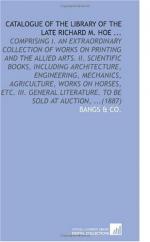|
This section contains 374 words (approx. 2 pages at 300 words per page) |
Encyclopedia of World Biography on Richard March Hoe
Richard March Hoe (1812-1886), American inventor and manufacturer, invented a high-speed printing press that helped revolutionize the newspaper industry in the United States.
Richard Hoe was born in New York City. After a common school education he went to work for his father, who manufactured printing presses. His father had begun experimenting with cylinder presses, and the younger Hoe carried on this work after his father retired in 1830. When Hoe finally perfected the single-cylinder press, it was capable of printing 2,000 pages (on one side) per hour. A cylinder press had been used to print the London Times as early as 1814, but Americans had been slow to adopt this method.
Hoe continued to improve his presses and was among the first to introduce a double-cylinder press, one cylinder of which carried the type and the other the paper to be printed. In 1847 he set up a press with five cylinders in Philadelphia. One cylinder carried the type, and the four others (each attended by a boy) fed sheets of paper against the first. This press was capable of making 8,000 impressions an hour.
The next major advance in printing appeared in 1865, when a press was invented that printed on a continuous roll of paper rather than on separate sheets. In 1871 Hoe began work on such a press and produced an improved model which could print (on both sides) 18,000 papers per hour. The addition of devices such as a machine to fold the newspapers (developed by a partner of Hoe) resulted in the modern high-speed printing press. Hoe's firm was the leading manufacturer of this equipment in the United States, and in the late 1860s he opened a branch factory in London.
Hoe's continually refined presses were of critical importance to the spread of news throughout expanding America during the 19th century. A literate and informed citizenry, capable of making its own political and economic choices, depended upon cheap and abundant news. The number of newspapers in the United States rose from 863 in 1830 to 3,725 in 1860. The Nov. 8, 1876, edition of the New York Sun, reporting the disputed presidential election between Rutherford B. Hayes and Samuel J. Tilden, ran to 220,000 copies. Such feats of rapid printing were possible only through the use of Hoe's steam-driven "lightning" presses.
|
This section contains 374 words (approx. 2 pages at 300 words per page) |


